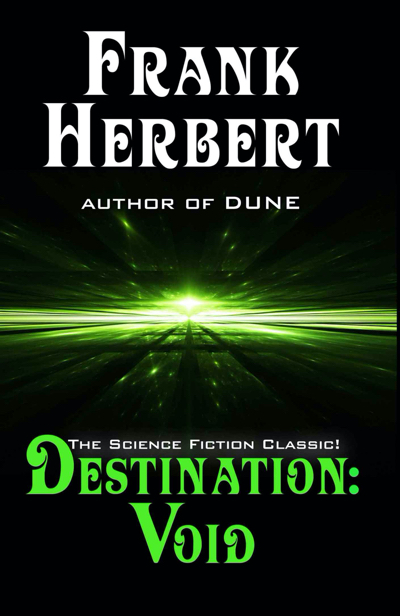January is Vintage Sci-Fi Month, but I hate to think of vintage sci-fi as confined to only one part of the year. So I’ll be making reviews of vintage science fiction, like Destination: Void and earlier classics, a regular feature of this blog. Follow Vintage Sci-Fi Month on Twitter and get in on the fun, too! As I recall, the rule for calling something “Vintage” is that it was written before you were born, but you can adjust that as you like.

In his revised 1978 version of Destination: Void Frank Herbert added several chapter heading quotes from Mary Shelley’s Frankenstein. Those quotes get to the heart of the story because they concern the creation of an artificial human.
Destination: Void is all about a space ship crew of artificial humans, or clones, and their attempt to create a new being of their own. As they struggle to survive on a ship possibly programmed for failure, they need to construct a new form of conscious computer to keep the mission alive. It’s one of the most intense dramas I’ve ever read. In fact, it reminds me of a powerful play that takes place in a near unity of time and place.
A Mission for Expendable Clones
A prologue establishes the key facts in a few pages. A space ship with a small crew of clones, and thousands more in hibernation tubes, has set off from a base on the moon to create a settlement on a planet in the Tau Ceti star system.
The director of the project, Morgan Hempstead, has already watched six previous missions self-destruct for various reasons. He doesn’t tolerate any shows of emotion from his staff or concern for the fates of the clones. He’s perfectly willing to see the seventh one go down as he drives the crew to achieve a breakthrough in leadership that will enable them to survive a series of pre-programmed failures.
Aside from that early glimpse of the moon base, all the action takes place on board the ship Earthling. But the presence of Hempstead is everywhere. He not only sends peremptory commands to the ship, he is also present in the indoctrination he has instilled into each clone, pushing them to fulfill the special role they have been designed to fill.
The Clone Crew
When we join the crew, the ship’s brains, known as Organic Mental Cores (because a human brain is at the center of each one), have already failed. Three crew members have died in grotesque accidents as a result.
The remaining three crew awaken a fourth to gain her special skills. They must then figure out how to guide the ship to its destination. While they can coordinate the ship’s controls manually, it takes intense concentration that wears each of them out. So they set about constructing a new component to add to the existing computer system. This new machine can only replace the old mental cores, the crew believes, if it can attain some form of consciousness.
As new failures continue to threaten the ship, the four crew contend with each other over their new creation, agonizing over each decision that takes them closer to a sentient being that could take control of their lives.
The four crew members include Bickel, who is designed as the leader in rationality and the ability to find solutions to the most complex problems. Flattery is a psychiatrist and chaplain who injects discussion about ethics and religion into each scene. Timberlake is the life-systems engineer who is designed to ensure the survival of the hibernating human and animal clones on board. Prudence has extraordinary insight in both medicine and mathematics.
Shifting Points of View
As he does in the Dune series, Herbert rapidly shifts perspective among his four characters. It’s like a play with the emotional weighting and thought behind each line made explicit in the private thoughts surrounding the spoken dialogue. It’s an especially effective way of creating narrative tension while driving the story forward.
Adding to the tension is that each of the four has special instructions unknown to the others, yet each also comes to realize that much has been kept from. They all come to believe that they have been lied to from the start.
Two of the characters understand that the mission is based on the theory that frustration heightens awareness and creates the conditions that force true intelligence to blossom and overcome the problems. They see Bickel as the one who is supposed to come through for the project to help it past each crisis. He does assume the leadership role, yet his efforts to create a sentient computer begin to frighten the other crew members.
They are all worried that there is something they don’t know. None of the four really trust each other, or at least can’t be sure how far to trust anyone else’s judgment. Their character differences also produce clashes, and tempers flare as the pressure on them mounts. The intricate balancing of multiple actions they need to take while operating the manual control board takes a toll. All experience the added pressure of having to fix things on the fly without any prior experience or training in these particular problems.
Achieving Clear Vision
Even though their awake lives have been brief, so none has lived a well-rounded human life, each one experiences the full range and depth of feelings in response to each crisis. And each one ultimately experiences a spectacular awakening and moment of insight when all the complex factors they have been juggling in their minds fall into place.
They achieve this clarity but only at a terrible cost. Following those dazzling moments they slump into deep fatigue and have to struggle to regain the insights that had filled them a short time before. All of this takes place in the midst of crisis as they approach a do-or-die moment that can send the ship into self-destruction, just as happened to the previous six missions.
They are also tormented over their nature as clones, seemingly human yet clearly labeled as expendable in a mission they begin to suspect has been meant to fail all along.
What Is Consciousness?
They contend with each other over the nature of consciousness and whether it could and should be programmed into the computer. Does consciousness emerge through emotions and the interaction with outside events? How would fear and guilt become part of this new entity they are trying to create? Does it have to incorporate the traumatic events and crises that instill fear and guilt?
Does consciousness depend on a background norm of some kind against which it can contrast itself? Is that background the knowledge that it could die? What sort of identity would this machine being have and what role does identity play in consciousness? The questions become more desperate, yet the crew has to act even without any certainty about the consequences of what they are creating.
It all builds to a remarkable climax this is satisfactory in itself but also forms the stepping off point for later books. (Herbert wrote those books in collaboration with Bill Ransom. They are The Jesus Incident, The Lazarus Effect and The Ascension Factor.)
The Technical Language
The problem many readers report with this book is the intricate discussion about technical tasks. That language may be dated, but it is consistent. It demands that the reader follow closely. Herbert did his homework in many fields and includes in the 1978 epilogue some of the mathematical formulas underlying certain parts of the discussion.
But the technical detail is not the main focus. The focus is always the substance of what the crew is trying to do by means of the details of computer schema, adjacent matrices, quantum physics and neurobiology. Deep explorations of the nature of self and the desperate need to take action of a demanding and highly technical nature, and the constant debates among the characters about what it is safe to do – these are the real centers of attention, rather than the technical language.
It is a demanding reading experience, but if you stay with it, I think you will find the story as gripping as I did. It is unrelenting drama, presented in a near unity of time, that builds to a remarkable climax in the final pages.




“It’s one of the most intense dramas I’ve ever read. ”
shut up and take my money! I’ve got a whole shelf of Herberts, and honestly do not remember if I have read this one or not. And thanks to your review, this is now a Must Read for me!
Thanks for stopping by. Which other Herbert novels besides the Dune series, do you recommend?
This was such a thorough review. Good job with it. You’re making me curious to give Destination: Void a shot even though it’s been a while since I read anything quite this demanding. 🙂